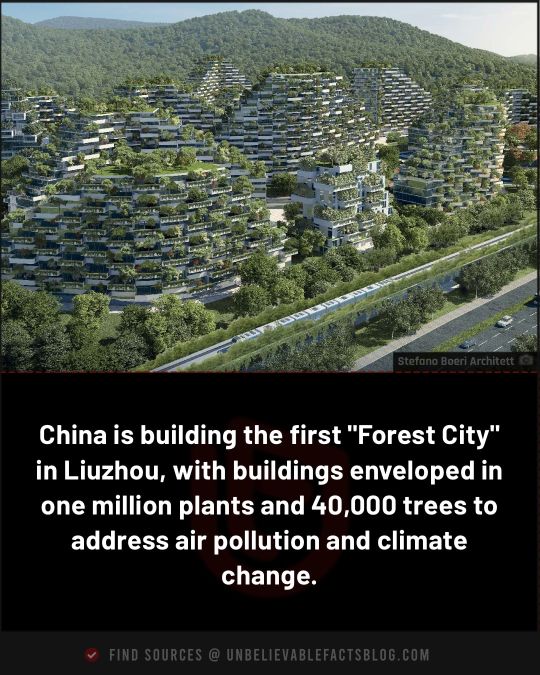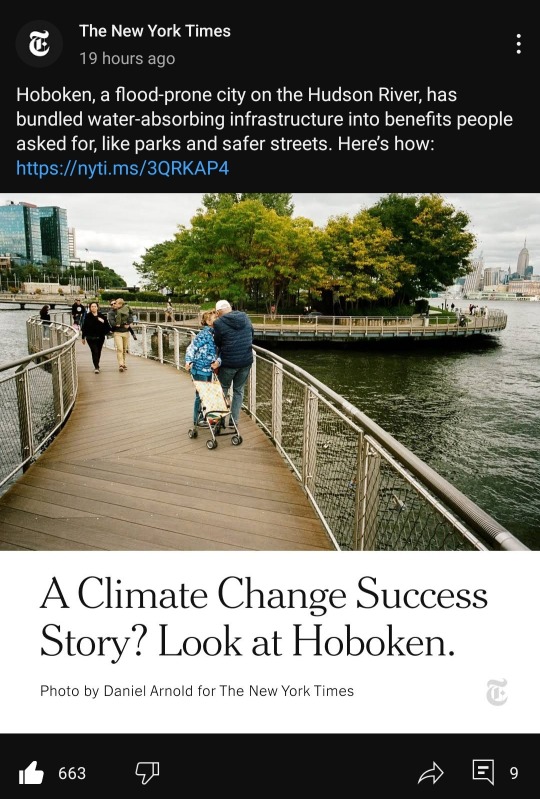#climate plans
Explore tagged Tumblr posts
Text
"With “green corridors” that mimic the natural forest, the Colombian city is driving down temperatures — and could become five degrees cooler over the next few decades.
In the face of a rapidly heating planet, the City of Eternal Spring — nicknamed so thanks to its year-round temperate climate — has found a way to keep its cool.
Previously, Medellín had undergone years of rapid urban expansion, which led to a severe urban heat island effect — raising temperatures in the city to significantly higher than in the surrounding suburban and rural areas. Roads and other concrete infrastructure absorb and maintain the sun’s heat for much longer than green infrastructure.
“Medellín grew at the expense of green spaces and vegetation,” says Pilar Vargas, a forest engineer working for City Hall. “We built and built and built. There wasn’t a lot of thought about the impact on the climate. It became obvious that had to change.”
Efforts began in 2016 under Medellín’s then mayor, Federico Gutiérrez (who, after completing one term in 2019, was re-elected at the end of 2023). The city launched a new approach to its urban development — one that focused on people and plants.
The $16.3 million initiative led to the creation of 30 Green Corridors along the city’s roads and waterways, improving or producing more than 70 hectares of green space, which includes 20 kilometers of shaded routes with cycle lanes and pedestrian paths.
These plant and tree-filled spaces — which connect all sorts of green areas such as the curb strips, squares, parks, vertical gardens, sidewalks, and even some of the seven hills that surround the city — produce fresh, cooling air in the face of urban heat. The corridors are also designed to mimic a natural forest with levels of low, medium and high plants, including native and tropical plants, bamboo grasses and palm trees.
Heat-trapping infrastructure like metro stations and bridges has also been greened as part of the project and government buildings have been adorned with green roofs and vertical gardens to beat the heat. The first of those was installed at Medellín’s City Hall, where nearly 100,000 plants and 12 species span the 1,810 square meter surface.
“It’s like urban acupuncture,” says Paula Zapata, advisor for Medellín at C40 Cities, a global network of about 100 of the world’s leading mayors. “The city is making these small interventions that together act to make a big impact.”
At the launch of the project, 120,000 individual plants and 12,500 trees were added to roads and parks across the city. By 2021, the figure had reached 2.5 million plants and 880,000 trees. Each has been carefully chosen to maximize their impact.
“The technical team thought a lot about the species used. They selected endemic ones that have a functional use,” explains Zapata.
The 72 species of plants and trees selected provide food for wildlife, help biodiversity to spread and fight air pollution. A study, for example, identified Mangifera indica as the best among six plant species found in Medellín at absorbing PM2.5 pollution — particulate matter that can cause asthma, bronchitis and heart disease — and surviving in polluted areas due to its “biochemical and biological mechanisms.”
And the urban planting continues to this day.
The groundwork is carried out by 150 citizen-gardeners like Pineda, who come from disadvantaged and minority backgrounds, with the support of 15 specialized forest engineers. Pineda is now the leader of a team of seven other gardeners who attend to corridors all across the city, shifting depending on the current priorities...
“I’m completely in favor of the corridors,” says [Victoria Perez, another citizen-gardener], who grew up in a poor suburb in the city of 2.5 million people. “It really improves the quality of life here.”
Wilmar Jesus, a 48-year-old Afro-Colombian farmer on his first day of the job, is pleased about the project’s possibilities for his own future. “I want to learn more and become better,” he says. “This gives me the opportunity to advance myself.”
The project’s wider impacts are like a breath of fresh air. Medellín’s temperatures fell by 2°C in the first three years of the program, and officials expect a further decrease of 4 to 5C over the next few decades, even taking into account climate change. In turn, City Hall says this will minimize the need for energy-intensive air conditioning...
In addition, the project has had a significant impact on air pollution. Between 2016 and 2019, the level of PM2.5 fell significantly, and in turn the city’s morbidity rate from acute respiratory infections decreased from 159.8 to 95.3 per 1,000 people [Note: That means the city's rate of people getting sick with lung/throat/respiratory infections.]
There’s also been a 34.6 percent rise in cycling in the city, likely due to the new bike paths built for the project, and biodiversity studies show that wildlife is coming back — one sample of five Green Corridors identified 30 different species of butterfly.
Other cities are already taking note. Bogotá and Barranquilla have adopted similar plans, among other Colombian cities, and last year São Paulo, Brazil, the largest city in South America, began expanding its corridors after launching them in 2022.
“For sure, Green Corridors could work in many other places,” says Zapata."
-via Reasons to Be Cheerful, March 4, 2024
#colombia#brazil#urban#urban landscape#urban planning#cities#civil engineering#green architecture#green spaces#urban heat#urban heat island effect#weather#meteorology#global warming#climate change#climate hope#climate optimism#climate emergency#climate action#environment#environmental news#city architecture#bicycling#native plants#biodiversity#good news#hope#solarpunk#ecopunk#hopepunk
17K notes
·
View notes
Text
TW: SA in the Work Place. Seeking Justice
Direct Aid:
Sorry I look disheveled. I am a broken person. All I ask is that you guys help me prove my past employer wrong. Help me fight.
💗 $400/$20,0000 raised

#immigration#politics#uk politics#donald trump#asexual#lesbian#gay#abortion#planned parenthood#comic#climate change#city#classic car#classroom#clouds#code#coding#collage#college#colonialism#Spotify
3K notes
·
View notes
Photo

Moldova’s climate plans have become sticky webs of intrigue, spinning outward beyond its borders. Threads of contention are tangled with separatists and Russian troops, forming an enigmatic web of fate that no one can comprehend nor unravel. Autonomous breakaway states, clandestine troop movements, and shifting allegiances all conspire to further ensnare the country’s basic rights to freedom of action. Government officials are forced to confront this ever-shifting landscape with a sense of dread, for any sudden move risks propelling a dangerous set of international dominoes that may lead to disaster on a larger scale. Peering through this fog of confusion and deception, what is the true will of the Moldovan people? Can its fate be more than just a plaything of powers beyond its control? The government can only hope to find a way forward, by navigating through the unpredictable currents of this uncertain time.
#Aluminum#Borders#Carbon#Companies#Electricity#Emissions#Energy#EU funding#Fertilizers#Fit for 55#Steel#Tax#Trade#Energy and Climate#Sustainability#fault#Moldova#climate plans#politics#war#separatists
0 notes
Text
we already have the percy whose scalp is always somewhat damp because he wants to feel the moisture on his skin. the percy who takes bubble baths twice a week soley so he can nap underwater when he's away from the beach. the percy who once drank four gallons of water in two hours and felt like he was king of the world for a week straight. but give me the percy who gets overstimulated from being in the water too much. the percy who spent his three-day weekend putting a stop to a war between the fish of the pacific and atlantic ocean. the percy who returned home with his hair dry as a bone. the percy who locked himself in his room and refused to touch water unless he was nearly dying of thirst. the percy who damn-near asked his father to disown him for a few days because being directly linked to water made him want to cry.
#i wish we got to see the extreme opposite of each demigod's respective domain#the annabeth who copes by doing impulsive shit every couple of weeks because constant meticulous planning makes her wanna tear her eyes out#the leo who migrates toward colder climates every few months to cope with constantly feeling like he's sitting in an oven#the piper who doesnt talk on weekends to cope with the consistent monitoring of her vocal inflections so she doesn't accidentally charmspea#the demigods who heavily rely on stimulation to function at 100 percent#but also have their 20% days so they don't drive themselves insane#percy jackon and the olympians#pjo text post#pjo#pjo headcanon#percy jackson#annabeth chase#piper mclean#leo valdez#the demigods
1K notes
·
View notes
Text

#China#Forest City#Liuzhou#urban planning#green architecture#air pollution#climate change#sustainability#environment#innovation
338 notes
·
View notes
Text
#hopecore#hopepunk#solarpunk#peaceful revolution#greenhorizon#anti capitalism#climate change solutions#naturecore#forestcore#lunarpunk#mutual aid#community#anarchism#urban planning#infrastructure#walkable cities#community projects#diy#pro social#intentional living
98 notes
·
View notes
Text

https://www.nytimes.com/2023/11/03/headway/hoboken-floods.html?unlocked_article_code=1.9kw.gbCb.cy56uUXSa4W2
"A study released by researchers for Rebuild by Design and Ramboll, an architectural engineering firm, suggests that every dollar invested in green infrastructure ultimately yields $2 in “avoided losses” (office closures, waterlogged inventories, flooded basements) and other benefits (improved home values and public health) [...] Just days before the September storm, New York’s mayor, Eric Adams, slashed $75 million that had been slated for the city’s Parks Department to deal with a budget crunch. Disinvestment in parks is going to cost the city in the long run because parks are a first line of defense against climate change."
433 notes
·
View notes
Text
💵💰💸
#climate change is a hoax#lies for profits and create fear#deep state’s plan to destroy the planet depopulate 7 billowing people and enslave the rest#environnement#environmetalists#we have been lied#manipulated and controlled by few extremely powerful individuals#wake up humanity#speak up#standup#seek truth#speaktruth#these people are evil#fight for justice#crimes against humanity#truth#please share#wwg1wga
539 notes
·
View notes
Text

2K notes
·
View notes
Text



sss day my favorite national holiday WOOOOHHHH
bonus

#pokemon#trainer lyra#rival silver#soulsilvershipping#timeskip tag#bao beis#i had so much more planned. but alas. college.#ANYWAY. sss my everything. ohh. always thinking abt them.#this is very obviously lyra's room! all the pink! massive bed to fit all her pokemon! the champion paycheck gets you that much at least#and plants!!! no. 1 horticulturist in johto#she's living somewhere around the base of mt silver... decently close to the league and her hometown#so i like to imagine her with a huge greenhouse so she can take care of plants even in the harsher climate#meanwhile silver has one of those decrepit malelivingspace flats in viridian. he's making it work.#i can only see sss properly moving in together liiiike in their late 20s#after they get to enjoy young adult independence for a while#but before they permanently settle down they should go on silly adventures again... just once. or twice. or#as much as i like to entertain the thought of them being homebodies i think they'd rather spend their lives travelling haha#since silver never got to fully experience it as a kid on the run#being a wanted man and all#and lyra is itching for the getaway#they deserve to be in nature and responsibility-free and *frothing at the mouth*#BTW i put my whole wyvussy into that wall decor#lisia signed poster... rosa's resemblance as mei(!!!) in the totoro one... bell tower + whirl island pics //#pokemon constellations... and those gen 4 mail templates that no one actually used. probably from dawn. champion penpals :]#i debated doing a lance poster because celebrity idol funny but nah she'd bin that immediately after moving out#oh yeah the drawover was um. inspired by the nonebinary neochamp fit. so happy for my son.#i'm glad i managed to finish the big piece in time otherwise i would've just posted that LOL can you imagine#okey bye happy sss day
275 notes
·
View notes
Text
Costa Rica generates around 99 percent of its electricity from renewable sources. How was the country able to accomplish that? Kenneth Lobo Méndez: The secret of this achievement is mainly planning. Identify the capacity of the different energy sources so you can get the big picture about how different resources can work together to get a renewable system. In the winter, like a six-month period from June to December, many of the hydropower plants get surplus flows. That’s when we have low wind, but we have more hydropower. And then in the summer, like from December to May perhaps, we get low hydropower, so the other sources of energy complement that electricity supply — mainly wind power, biomass, and geothermal.
[...]
In the US, we’re used to many smaller private electric utilities. Does having a national energy company like ICE make it easier to adopt renewable energy? KLB: In our perspective, yes, it’s an advantage that the planning is held by a government state company. It can make a plan for the country according to the government’s vision. We only sell what we need, and there’s no interference from different stakeholders. It makes the planning process more simple.
211 notes
·
View notes
Text
"Amsterdam’s roofs have just been converted into a giant sponge that will make the city more climate resilient.
The Dutch have always been famous for their ability to control water, born out of the necessity of their homeland, much of which is below sea level.
Now, their expert water management skills are transforming the city skyline in the capital city of Amsterdam from one of terracotta tile, concrete, and shingles into green grass and brown earth.
It’s part of a new climate-resiliency trend in architecture and civic planning known as the ‘sponge city concept,’ in which a garden of water-loving plants, mosses, and soil absorbs excess rainwater before feeding it into the building for use in flushing toilets or watering plants on the ground.
If heavy rains are predicted, a smart valve system empties the stored rainwater into the municipal storm drains and sewers in advance of the weather, allowing the roof to soak up water and reduce flooding in the city.
In this way, the rooftops of buildings can be wrung out and filled up just like a sponge.
In Amsterdam, 45,000 square meters, or 11 acres of flat metropolitan rooftops have already been fitted with these systems, and the contracting firms behind the technology say they make sense in dry climates like Spain just as much as in wet climates like Amsterdam...
A 4-year project of different firms and organizations called Resilio, the resilient network for smart climate adaptive rooftops, rolled out thousands of square meters of sponge city technology into new buildings. As with many climate technologies, the costs are high upfront but tend to result in savings from several expenditures like water utilities and water damage, over a long-enough time horizon...
All together, Amsterdam’s sponge capacity is over 120,000 gallons.
“We think the concept is applicable to many urban areas around the world,” Kasper Spaan from Waternet, Amsterdam’s public water management organization, told Wired Magazine. “In the south of Europe–Italy and Spain–where there are really drought-stressed areas, there’s new attention for rainwater catchment.”
Indeed the sponge city concept comes into a different shade when installed in drought-prone regions. Waters absorbed by rooftops during heavy rains can be used for municipal purposes to reduce pressure on underground aquifers or rivers, or be sweated out under the Sun’s rays which cools the interior of the building naturally.
Additionally, if solar panels were added on top of the rooftop garden, the evaporation would keep the panels cooler, which has been shown in other projects to improve their energy generation.
“Our philosophy in the end is not that on every roof, everything is possible,” says Spaan, “but that on every roof, something is possible.”
Matt Simon, reporting on the Resilio project for Wired, said succinctly that perhaps science fiction authors have missed the mark when it came to envisioning the city of the future, and that rather than being a glittering metropolis of glass, metal, and marble as smooth as a pannacotta, it will look an awful lot more like an enormous sculpture garden."
-via Good News Network, May 15, 2024
#amsterdam#netherlands#green roof#blue roof#city planning#urban#urban landscape#flood#climate change#climate action#climate emergency#climate hope#solarpunk#hope posting#go green#eco friendly#climate adaptation#sponge city#urban planning#good news#hope#rooftop garden
2K notes
·
View notes
Text
The United States is experiencing scorching new levels of heat fueled by climate change this summer, with dozens of people dying in the West, millions sweating under heat advisories and nearly three-quarters of Americans saying the government must prioritize global warming.
But as the Republican Party opens its national convention in Milwaukee with a prime-time focus on energy on Monday night, the party has no plan to address climate change.
While many Republicans no longer deny the overwhelming scientific consensus that the planet is warming, party leaders do not see it as a problem that needs to be addressed.
“I don’t know that there is a Republican approach to climate change as an organizing issue,” said Thomas J. Pyle, president of the American Energy Alliance, a conservative research group focused on energy. “I don’t think President Trump sees reducing greenhouse gases, using the government to do so, as an imperative.”
When former President Donald J. Trump mentions climate change at all, it is mockingly.
“Can you imagine, this guy says global warming is the greatest threat to our country?” Mr. Trump said, referring to President Biden as he addressed a rally in Chesapeake, Va., last month, the hottest June in recorded history across the globe. “Global warming is fine. In fact, I heard it was going to be very warm today. It’s fine.”
He went on to dismiss the scientific evidence that melting ice sheets in Antarctica and Greenland are causing seas to rise, threatening coastal communities around the world. He said it would result in “more waterfront property, if you’re lucky enough to own.” And he lapsed into familiar rants against windmills and electric vehicles.
At the televised debate with Mr. Biden in June, Mr. Trump was asked if he would take any action as president to slow the climate crisis. “I want absolutely immaculate clean water and I want absolutely clean air, and we had it,” Mr. Trump responded, without answering the question.
Mr. Trump’s spokeswoman, Karoline Leavitt, later declined to clarify the former president’s position or discuss any actions he would take regarding climate change, saying only that he wants “energy dominance.”
The United States last year pumped more crude oil than any country in history and is now the world’s biggest exporter of natural gas.
A clear majority of Americans, 65 percent, wants the country to focus on increasing solar, wind and other renewable energy and not fossil fuels, according to a May survey by the Pew Research Center. But just 38 percent of Republicans surveyed said renewable energy should be prioritized, while 61 percent said the country should focus on developing more oil, gas and coal.
“Their No. 1 agenda is to continue producing fossil fuels,” said Andrew Dessler, a professor of atmospheric sciences and the director of the Texas Center for Climate Studies at Texas A&M University. “Once you understand their main goal is to entrench fossil fuels regardless of anything else, everything makes sense.”
The party platform, issued last week, makes no mention of climate change. Instead, it encourages more production of oil, gas and coal, the burning of which is dangerously driving up global temperatures. “We will DRILL, BABY, DRILL,” it says, referring to oil as “liquid gold.”
By contrast, Mr. Biden has taken the most aggressive action of any president to cut emissions from coal, oil and gas and encourage a transition to wind, solar and other carbon-free energy. He has directed every federal agency from the Agriculture Department to the Pentagon to consider how climate change is affecting their core missions.
If Mr. Biden has taken an all-of-government approach to fighting climate change, Mr. Trump and his allies would adopt the opposite: scrubbing “climate” from all federal functions and promoting fossil fuels.
Mr. Trump and his allies want to end federal subsidies for electric vehicles, battery development and the wind and solar industries, preferring instead to open up the Alaskan wilderness to oil drilling, encourage more offshore drilling and expand gas export terminals.
Project 2025, a lengthy manual filled with specific proposals for a next Republican administration, calls for erasing any mention of climate change across the government. While Mr. Trump has recently sought to distance himself from Project 2025, he has praised its architects at the Heritage Foundation, a conservative research organization, and much of the plan was written by people who were top advisers during his first term and could serve in prominent roles if he wins in November.
When pressed to discuss climate change, some Republicans say the country should produce more natural gas and sell it to other countries as a cleaner replacement for coal.
While natural gas produces less carbon dioxide than coal when burned, it remains one of the sources of the greenhouse gases that are driving climate change. Scientists say that countries must stop burning coal, oil and gas to keep global warming to relatively safe levels. Last year, at the United Nations climate summit in Dubai, United Arab Emirates, the United States and nearly 200 countries agreed to transition away from fossil fuels.
But if elected, Mr. Trump has indicated he would pull back from the global fight against climate change, as he did when he announced in 2017 that the United States would be the first and only country to withdraw from the Paris Agreement to limit greenhouse gas emissions. (The United States subsequently rejoined under Mr. Biden.)
And it’s possible he would go even further. Mr. Trump’s former aides said that if he wins in November, he would remove the country altogether from the United Nations Framework Convention on Climate Change, the international body that works on climate policy and created the 2015 Paris deal.
When it comes to international relations, Project 2025 calls for an end to spending federal funds to help the world’s poorest countries transition to wind, solar and other renewable energy.
The blueprint also calls for erasing climate change as a national security concern, despite research showing rising sea levels, extreme weather and other consequences of global temperature rise are destabilizing areas of the world, affecting migration and threatening American military installations.
Federal research into climate change would slow or disappear under Project 2025, which recommends dismantling the National Oceanic and Atmospheric Administration, which conducts some of the world’s leading climate research and is also responsible for weather forecasting and tracking the path of hurricanes and other storms.
NOAA, according to the authors of Project 2025, is “one of the main drivers of the climate change alarm industry and, as such, is harmful to future U.S. prosperity.” At the agency’s research operation, which include a network of research laboratories, an undersea research center, and several joint research institutes with universities, “the preponderance of its climate-change research should be disbanded,” the blueprint said.
Project 2025 also calls for the president to issue an executive order to “reshape” the program that convenes 13 federal agencies every four years to produce the National Climate Assessment, the country’s most authoritative analysis of climate knowledge. The report is required by Congress and details the impacts and risks of climate change to a wide range of sectors, including agriculture, health care and transportation. It is used by the public, researchers and officials around the country to inform decisions about strategies and spending.
Project 2025 also calls for the elimination of offices at the Department of Energy dedicated to developing wind, solar and other renewable energy.
Waleed Abdalati, a former NASA chief scientist who is now at the University of Colorado Boulder, said downgrading climate science would be a disservice to the nation. “That’s a loss of four years in pursuit of creative solutions,” he said.
As president, Mr. Trump tried to replace top officials with political appointees who denied the existence of climate change and put pressure on federal scientists to water down their conclusions. Scientists refused to change their findings and attempts by the Trump administration to bury climate research were also not successful.
“Thank God they didn’t know how to run a government,” Thomas Armstrong, who led the National Climate Assessment program under the Obama administration, said at the end of Mr. Trump’s presidency, adding, “It could have been a lot worse.”
Next time, they would know how to run the government, Mr. Trump’s former officials said. “The difference between the last time and this time is, Donald Trump was president for four years,” Mr. Pyle said. “He will be more prepared.”
#climate change#climate action#global warming#Donald Trump#Trump#politics#us politics#american politics#election 2024#Republicans don't just not have a plan to fight climate change#they have a plan to make it much worse#the planet is on the line people
107 notes
·
View notes
Photo

A peculiar current of energy washes across Moldova, a mysterious crossroads of climate plans, separatists, and Russian troops, where the fate of the country hangs in the balance. The tapestry of vested interests and conflicting agendas stretches deep into the heart of Moldova, creating a strange tension between the distant reality of the land and the deep machinations of its schemers and planners. Political elements of the past have become intertwined with the future, leaving Moldova full of unanswered questions. Amidst this tension, citizens of Moldova cling to dreams of a better future, although none can predict what is to come, for the power of the climate seems to be ever in flux, steeped in a delicious uncertainty.
#Aluminum#Borders#Carbon#Companies#Electricity#Emissions#Energy#EU funding#Fertilizers#Fit for 55#Steel#Tax#Trade#Energy and Climate#Sustainability#fault#Moldova#climate plans#politics#war#separatists
0 notes
Text
Normalize updating laws and regulations that are no longer fit for purpose.
Normalize working with powerful enemies to find a solution where everybody wins.
Normalize mutual compromise.
Normalize collaboration over opposition.
Normalize civil discourse on divisive issues.
Normalize good faith and the principle of charity.
Normalize discussion of specific social, political, and economic issues.
Normalize advocacy for specific and implementable policy reforms to to tackle said issues.
Normalize imperfect solutions.
Normalize civic engagement.
Normalize public sector action.
Normalize incremental success.
Normalize improving society instead of destroying and rebuilding it from the ground up.
NORMALIZE PROGRESS!!!
#solarpunk#hopepunk#politics#political discourse#public policy#civic engagement#civic duty#georgism#transit#urban planning#accessibility#disability justice#disabled#healthy politics#policymakers#social justice#societal improvement#retain hope#societal progress#climate change#climate action#advocacy#trains#political activist#political action#activism#hanlon's razor#good regulations work#good faith arguments#good faith
246 notes
·
View notes
Text

The Maldives Floating City, set to open in 2027, will provide eco-friendly, floating residences for 20,000 people, adapting to rising sea levels.
#Maldives#floating city#climate change#sea level rise#eco-friendly architecture#sustainable living#urban planning#2027#innovative design
64 notes
·
View notes